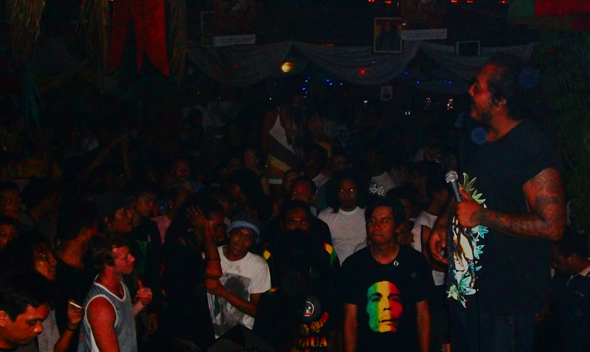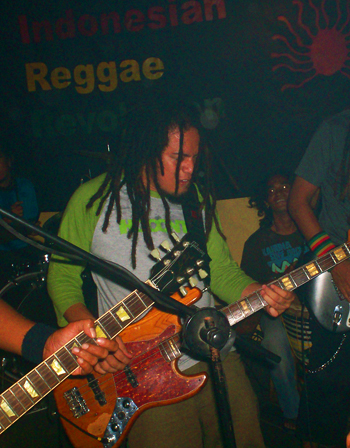Dreadlocked Indonesians adopt the Jamaican music form to speak of local socio-political issues
Lisa Colquhoun
Steven and CoconuTTreez have been credited with propellingIndonesian reggae into the spotlightLisa Colquhoun |
The 1980s saw the introduction of reggae to the beachside tourist bars of Bali and Lombok. Disconnected from its roots as resistance to colonial exploitation, it was instead performed as the hollow soundtrack for tipsy tourists on holiday in paradise.
Local visitors to the bars that had become known for live reggae, including Bruna Bar on Bali’s Kuta Beach and Pondok Senggigi on Lombok’s west coast, were gripped by reggae’s gentle rhythm and its invitation to sway. For the most part, they had no understanding of what reggae was really all about; after all, most couldn’t comprehend the Jamaican-accented English of the lyrics. As Joe – who frequented Pondok Senggigi in the early 1990s, and later fronted a string of popular reggae bands in Indonesia, including his current Gili Trawangan-based band, Mellow Mood – confessed, ‘I didn’t know what they were singing about. I would just watch the tourists dance, see the effect that reggae had on them and on me – no hurry hurry. That is why I chose reggae.’
But this initial attraction to the rhythm soon developed into a curiosity about reggae’s subject matter. Bali’s most celebrated reggae artist, Joni Agung, recalls spending hours investigating the definitions of every word in selected Bob Marley songs using an English dictionary, only to discover that reggae spoke of something very different to the images of a lazy tropical paradise evoked by its relaxed rhythm. Reggae’s themes of sweeping corruption, colonialism and the disparity between rich and poor resonated with Joni and others who felt that their own lived experiences were represented in the lyrics of Bob Marley. As Tony Q, the undisputed legend of Indonesian reggae, commented, ‘Reggae said all the things that I had wanted to say.’
The urban shift
The 1997-98 Asian Financial Crisis followed by the 2002 terrorist bombings in Kuta devastated the tourism industries in both Bali and Lombok and robbed reggae of its target audience in Indonesia. The main venues for live reggae closed down and for a while the community of dreadlocked Indonesians who had developed quite an attachment to the music had no place to go.
But in Jakarta former country-musician Tony Q was attracting a marginal following with his hybrid version of reggae. Singing in Indonesian and occasionally backed by Javanese gamelan or Sundanese gendang, Tony Q appealed to the city’s youth, who were craving alternatives to the Western and Western-style pop and rock that dominated the airwaves and music television. Other Jakartan reggae bands, including Asian Roots and Tuff Gong, were also garnering attention with their Indonesian reggae tunes and small reggae scenes, largely invisible to the mainstream, began popping up in other urban centres including Yogyakarta and Medan.
The popularity of reggae music in Indonesia, and of Indonesian reggae in particular, grew with the 2006 release of Jakarta-based Steven and CoconuTTreez’s debut album, The Other Side, which incorporated a mix of catchy Indonesian and English language pop-reggae tunes. The album's most revered song, 'Welcome To My Paradise', which was written by vocalist Tpenk during a visit to Lombok’s Gili Trawangan, celebrated freedom from the drudgery of modern living. Its universal theme of searching for happiness and harmony in a bleak world struck a chord with disillusioned Indonesian youth, who also wanted to find ‘a place where we can dance and drink, a place where we can share some weed, a place where there's no bullshit and everybody can come.’
 |
Bali’s Joni Agung performs his original Balinese-language tunes to a mixed crowd of Indonesians and foreign tourists atApache Reggae Bar in KutaLisa Colquhoun |
Not only did the song and the album capture the imagination of Indonesian youth in remarkable numbers, but it also brought reggae music back to Indonesia’s tourism industry. By 2006, tourist numbers had bounced back from post-bombing lows, and The Other Side was played on high rotation throughout Bali and Gili Trawangan, often at the request of those tourists. Pirated copies of the album were sold by hawkers on the streets and taken home by foreign visitors. Reggae was being re-exported as an Indonesian product.
Reggae revolution
Owing to the archipelago-wide success of Steven and CoconuTTreez, reggae music scenes proliferated throughout the archipelago. Seemingly overnight, every major town had their resident reggae band or artists, who were seen to actively and consciously engage in the localisation of reggae music in the vein of Tony Q. Record labels may for the most part have been disinclined to sign up groups of dreadlocked ganja-smokers, but online broadcasting and social-networking sites facilitated the distribution of Indonesian reggae, and what is locally known as the ‘Indonesian Reggae Revolution’ was born.
The Indonesian reggae revolution took Indonesian reggae to a whole new level. According to the self-professed Indonesian reggae ambassador to the world, Ras Muhamad, there was now a greater sense of obligation for the producers of Indonesian reggae to serve as ‘messengers’ to consumers. Although Bali’s Joni Agung believes the form of reggae music should adapt to local sensibilities he agrees that Indonesian reggae musicians should not ignore reggae’s capacity to communicate social and political messages to its audiences. As Ras Muhamad puts it, reggae, whether Jamaican, Indonesian or otherwise, is inherently ‘rebel music’.
Many Indonesian reggae musicians have taken advantage of Indonesian reggae’s new-found popularity to express social and political concerns relevant to their audiences. Indonesian reggae artists speak out about such locally-specific issues and phenomena as youth unemployment in Lombok (Joe and Mellow Mood’s ‘Lombok Holiday’) and the destruction of Indonesia’s rice paddies in the wake of increasing urbanisation (Tony Q’s ‘Anak Kampung’). Indonesian reggae has also provided a space for public criticism of current and past regimes without threat of censorship or government denunciation, as Ras Muhamad’s highly critical albums and music videos demonstrate. Reggae has even been adopted in parts of the archipelago as an expression of separatist ambitions, such as by Ambon's D'Embalz.
Many Indonesian reggae musicians have taken advantage of Indonesian reggae’s new-found popularity to express social and political concerns relevant to their audiences
But despite reggae’s freedom from government censure, many Indonesian reggae artists admit to holding back somewhat from overt political commentary. Yogyakarta-based bands Marapu and Shaggydog, for example, suggest that politics should gradually find its way into Indonesian reggae so not to overwhelm inexperienced audiences. For both bands, the priority is to establish large and loyal fan-bases through the exploration of more general themes of peace and universal love. If reggae music is to be an effective vehicle for political expression, they argue, the audience must be as big as possible, as well as being willing and ready to listen. ‘We must know our market first, then we can make a difference,’ declared Heru, the lead vocalist of Shaggydog.
A cosmopolitan site
The performance and appreciation of reggae in Indonesia was once limited to cheery cover versions of classic Bob Marley tunes in the beachside resorts of Bali and Lombok. It now speaks to Indonesian audiences about issues and phenomena that affect them, in a language that they can understand. In a market dominated by love songs, Indonesian youth are turning to reggae in increasing numbers, finding in it a voice for political expression.
But Indonesian reggae is beginning to attract international attention. A number of Indonesian reggae acts have been invited to perform overseas and others have had their tunes included in international reggae compilation albums. Just as Indonesians had sought to understand the content of the tunes of Bob Marley in the 1980s and 1990s, foreign visitors are now scouring Indonesian dictionaries to translate the lyrics of their favourite Indonesian reggae tunes. A scan of the MySpace and Facebook pages reveals just how international the audience for Indonesian reggae has become. Not only, then, has reggae been adopted and localised over time, engaging an Indonesian audience in socio-political discourse. It has also become an increasingly cosmopolitan site where reggae fans from all corners of the world encounter Indonesia.
Lisa Colquhoun (lisac1983@hotmail.com) wrote an Honours thesis about Indonesian reggae at Sydney University’s Department of Indonesian Studies.












